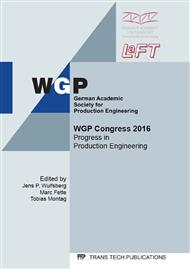p.173
p.181
p.189
p.197
p.205
p.213
p.221
p.228
p.239
Thermal Modelling of Drilling Steel
Abstract:
The modelling of machining operations aiming at the compensation of thermal effects regarding workpiece distortion requires detailed knowledge of the thermal impact of the examined process. The objective of this paper is therefore to form an empirical basis for the modelling of the heat flux into the workpiece in drilling of steel. In order to achieve this goal the temperature matching technique in combination with two dimensional thermographic measurements was utilised. The moving heat source was characterised as a primary heat source with a constant heat flux density near the cutting zone and a secondary declining heat source on the bore hole wall. With an iterative approach it was possible to match the simulated temperature fields very closely to the measured temperature fields. The evaluation of the thermal impact of the drilling process with varying machine parameters yielded additional insight into the generation and distribution of thermal energy in drilling. The lowest overall heat partition to the workpiece was observed at the higher feed rate in combination with the lower cutting speed where the heat partition in the cutting zone as well as heat transfer to the bore hole wall are minimal.
Info:
Periodical:
Pages:
205-212
Citation:
Online since:
August 2016
Authors:
Keywords:
Price:
Сopyright:
© 2016 Trans Tech Publications Ltd. All Rights Reserved
Share:
Citation:


